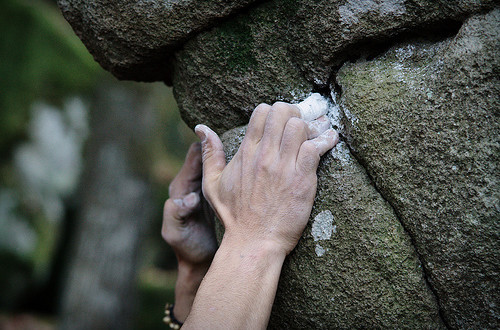by Michelle Sutton-Kerchner
Our hands are powerful tools. Whether lending one or using them for yourself, hands get the job done. Keep them strong and give them some well-deserved attention …
 We use them to play ball, strum instruments, sign contracts, feed ourselves. Fingers are there to scratch an itch, massage an injury, or perform delicate tasks from surgery to needlepoint. Treat them well, make them stronger and more flexible. Ease stiffness from arthritis or soreness from the tensions of texting and typing. Take fitness to these extremities.
We use them to play ball, strum instruments, sign contracts, feed ourselves. Fingers are there to scratch an itch, massage an injury, or perform delicate tasks from surgery to needlepoint. Treat them well, make them stronger and more flexible. Ease stiffness from arthritis or soreness from the tensions of texting and typing. Take fitness to these extremities.
Hand Fitness
Neglecting hands and arms can lead to muscle and joint discomfort, including that associated with arthritis. We often don’t think of hand muscles and their significance in our fitness routine. Yet, spend one day with your hand wrapped in a bandage and quickly see the challenge placed upon other muscles as they compensate. (Not to mention, exercising with equipment can be impossible. Even without using equipment, an inactive hand is deadweight that suddenly can feel like 20 extra pounds.)
Stretch
Stretching arms and hands after exercise and everyday activities, including life’s myriad keyboarding tasks, alleviates tension build up that leads to stiffness and pain. Fingers dance along throughout the day at intense speed, often performing thankless tasks. As with any physical exertion, stretching prevents injury and stiffness.
Many muscles responsible for controlling the hands are in the forearm. Muscles in the front of the arm flex fingers; muscles in the back of the arm extend the fingers. Stretches should focus on forearms, along with tendons and ligaments in the hand, for optimum flexibility and range-of-motion.
A personal trainer can demonstrate simple hand stretches to perform throughout your day. Wrist rotations and forward/reverse hand stretches can be completed in a few minutes, anywhere. Try them while heating lunch in the microwave or paused in thought at the computer. Keep joints limber and release tensions to maintain pain-free texting, tossing, and, yes, TV watching (operation of the remote-control).
Strengthen
Intrinsic and extrinsic muscles are the major players that control activity in the hand, with the extrinsic running as far as the forearm to coordinate finger movement. Strengthen these muscles to help reduce joint stress and relieve pressure on tendons. This can ease common hand pain, an annoyance of which you may not even be aware, and arthritis, a painful condition of which you certainly are aware and to which you may feel helpless.
Incorporate weights: Using free weights simultaneously strengthens hand muscles as you focus elsewhere on the body. Although, we don’t typically pick up weights with the goal of stronger hands, it happens in the process. Strengthening starts at the first grip of a dumbbell or barbell. Muscles that flex fingers and wrists are instantly engaged. The lifting process adds to your hands’ workout and increases intensity as you are able to lift heavier weight.
Try these hand-strengtheners, recommended by personal trainers:
- Dead Lift Hold: Grip a barbell with both hands in the overhand position or kettlebells at your sides. Lift from the floor. Keep form proper, with shoulders back and legs firm. Squeeze barbell or kettlebells tightly. Hold weight until hands reach their limit, then bend forward and return weight to the floor. Rest and repeat.
- Plate Pinch: Finger fitness is the focus here. Place two smooth weight plates on their edges. Clasp the plates together by squeezing as tightly as possible with one hand. Lift the plates off the floor and hold by your side (not over your feet). As grip weakens, return plates to the floor. Switch hands.
Trainer Ashley Lion also recommends modalities like TRX to go along with kettlebells. “Your grip and the connection with wrists, elbows, and shoulders is important with these methods. It yields impressive results for the hands in the process,” she indicates.
Ashley confirms, “Usually, hands aren’t the focus as a separate entity. Rather, we add them into a strengthening program in a more functional way.” Hands are trained during pulling and pushing exercises by using various grip positions and handle widths. Ashley also notes hands are an extension of the shoulders, as demonstrated in an exercise called “farmer’s carries.” She informs, “Shoulders need to do their job with proper form so hands can perform successfully.”
To add a specific hand-focused dimension to strength training, Ashley recommends attaching grippers to the various bars and handles found on exercise equipment. This increases the challenge to hands and shoulders.
Hands will be ready for warranted fist-pumping cheers. The benefits of a strength training program expand to include stronger bones throughout the body, healthier weight, better balance and focus, and increased stamina.
Hands alone: There are exercise tools especially created for hand workouts. However, a simple tennis ball can be enough for basic hand fitness. Firmly hold the ball in the palm of your hand and squeeze as tightly as possible. Stop before becoming uncomfortable. Hold for five seconds; repeat ten times. Perform three times weekly.
Practice caution with strengthening exercises that target hands. Hands are involved in many aspects of daily functioning and fitness, especially if you are weight training. Muscles easily can become overworked and cause the pain in hands, wrists, and forearms you are working to avoid.
In a Pinch
Flexibility and strengthening exercises cannot undo conditions that affect the hands, such as carpal tunnel syndrome. However, exercise can help prevent pinched nerves that present with similar symptoms. Numbness or decreased sensation in an area supplied by the nerve (not only the hand), tingling, and weakness are sometimes signs of a pinched nerve. A pinched nerve located in the neck may travel to extremities, right out the fingers, and negatively impact the entire area in between.
 It is essential to recognize the body as an intricate being of energy and movement. True wellness requires a healthy radiance. Unaware, we often ignore the small twinge that warns of future trouble. Think of that kink in your back that triggers pain to your toes over time. Eventually, what was a tweaked muscle or sore joint may lead to an arthritic outcome. Pain leads to reduced activity, which spirals to cause additional health issues.
It is essential to recognize the body as an intricate being of energy and movement. True wellness requires a healthy radiance. Unaware, we often ignore the small twinge that warns of future trouble. Think of that kink in your back that triggers pain to your toes over time. Eventually, what was a tweaked muscle or sore joint may lead to an arthritic outcome. Pain leads to reduced activity, which spirals to cause additional health issues.
A proper fitness program, which evolves with your day-to-day situations, can improve functioning and reduce the aches and joint stiffness found in the arthritic patient and textaholic.
The bases are loaded. The ball is headed your way. Be strong– hands included. Don’t let opportunities slip from your grip.
Sources
“How to Build Hand Muscles,” by Paula Quinene at www.livestrong.com.
“How to Stretch Hand Muscles,” by Janice Jones at www.livestrong.com.
“Pinched Nerve,” at www.mayoclinic.com.
Image Credits
Climbing hands (introductory photo): http://www.flickr.com/photos/liquene/4138287848/
Holding hands: http://www.flickr.com/photos/janiiiiii/5922178637/
Baseball grip: http://www.flickr.com/photos/glasgows/444683385/
 Fitness & Wellness News Your Source for Fitness News, Wellness News, Health News, and Nutrition News!
Fitness & Wellness News Your Source for Fitness News, Wellness News, Health News, and Nutrition News!




